699 Search Results for communication book
December 13, 2013
by Carole Zangari -
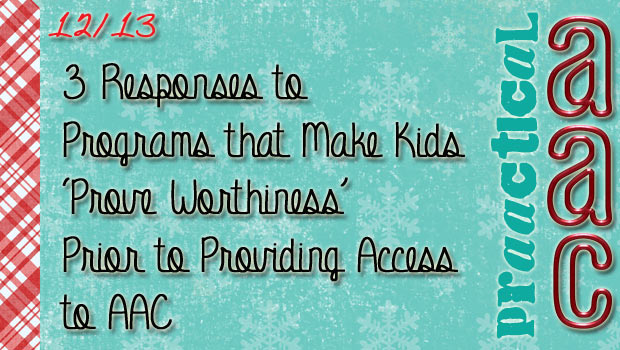
Like many of you, we continue to hear about programs that withhold AAC supports from children who are nonverbal or minimally verbal. Sometimes they point to the perceived lack of readiness that the child has for AAC, in general. Other times, they erect barriers, such as an artificial benchmark that insists that children start with no-tech AAC (e.g., communication boards, books, PECS) or low tech SGDs before ‘earning the right’ to sophisticated AAC options. As yet another year comes to a close, it is hard to believe that there are still programs, administrators, or, worse yet, our SLP colleagues who think they are truly justified in limiting access to AAC. How can we move beyond tearing our hair out, drinking excessively, or ranting to our friends? Here are some ideas. “Show me the evidence.” Ask for empirical support for the position that withholding access to AAC tools and strategies is more... [Read More...]
December 7, 2013
by Carole Zangari -
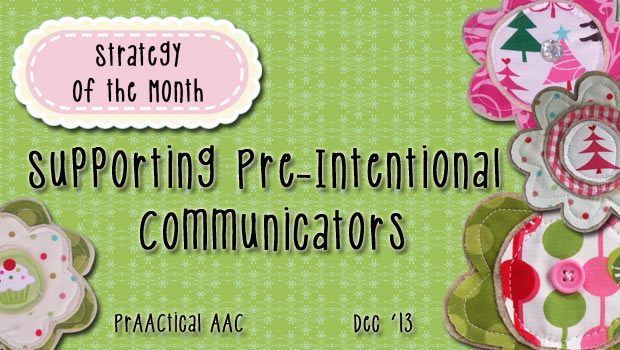
Scene 1 Alex looks at the picture symbol choices placed in front of him and knocks them to the floor. Simone looks distressed while she waits for her lunch and whines as she watches her classmates eating. Jason smiles engagingly and rocks enthusiastically when his favorite aide enters the room. Kyra takes a picture from her PECS book and begins to chew on it. Scene 2 “He can’t even make choices. I’m not even sure what he wants.” “She really doesn’t communicate.” “He doesn’t mean anything by it. He does that all the time.” “She needs hand-over-hand prompting for everything.” Great kids, caring professionals. Ineffective communication. This month, we focus on ways to support children and adults at the earliest stages of communication. It isn’t easy trying to figure out how to provide effective SLP services to individuals who are not yet sending messages intentionally. Communicators at the pre-intentional level are... [Read More...]
November 30, 2013
by Robin Parker -
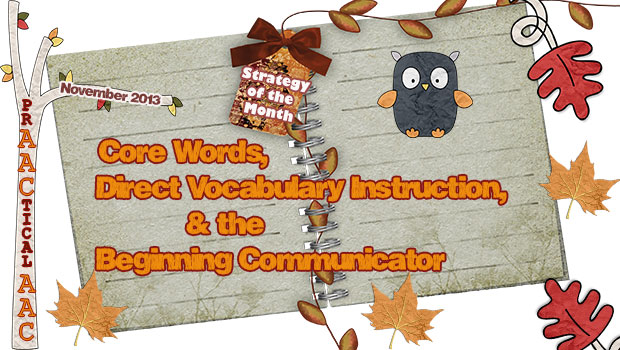
Direct vocabulary instruction is important for all level learners. The beginning communicator needs to learn core word vocabulary from USING the words and one of the best ways to learn how to USE core words, is to receive specific direct instruction with many opportunities for active participation. 6 Essential Philosophies & Strategies Vocabulary instruction involves a systematic TEACHING process. Add vocabulary or Words as an activity on the daily schedule and then have a mini-schedule for the specific vocabulary instruction activities for that day. Initially, apply an errorless learning paradigm. Then, gradually, add comprehension checks, but do not wait for ‘proof’ of comprehension before adding new words because we often notice that the beginning communicator will demonstrate comprehension during ‘unexpected opportunities- or when you are least expecting it. Once learners become familiar with some of the specific vocabulary activities, then have some choice making opportunities as to which ‘word activities’... [Read More...]
November 12, 2013
by Carole Zangari -
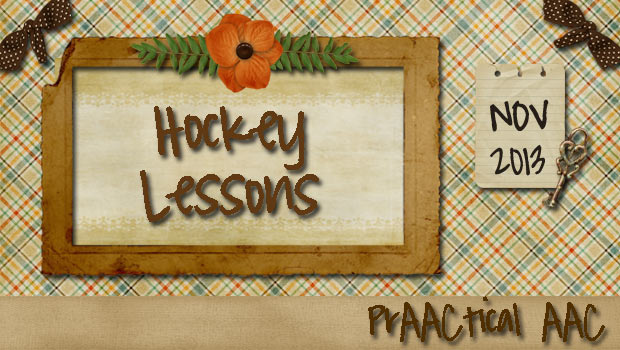
When WrightsLaw posted the video below on Facebook, we just had to share it on our PrAACtical AAC FB page. If you haven’t seen this clip from Special Hockey International, do yourself a favor and watch it. We may not be the world’s biggest hockey fans, but we got something quite meaningful from this clip and think you will, too. Here are the some of the things we’ve been pondering after watching the video. 1. Friendship matters. Teaching friendship skills is central to our mission as SLPs, not a trivial thing that we might focus on after all the other goals are accomplished. If our AAC learners have no real relationships outside of their own families and those professionals and caregivers paid to work with them, how much impact have our therapies really made? If they are lonely, has what we’ve done really mattered? 2. A single act of kindness can change... [Read More...]
November 11, 2013
by Robin Parker -
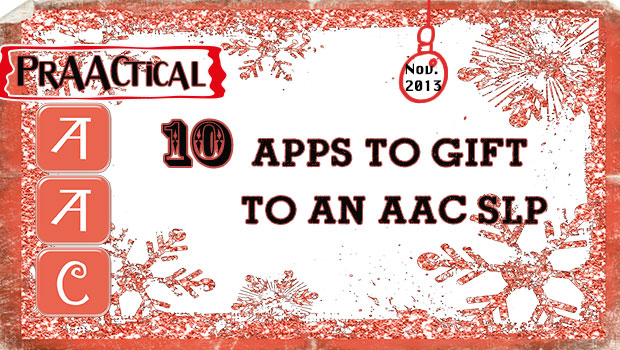
It’s definitely time to think about the holidays because they are almost here. Apps are often a great gift for your colleagues or for the SLP working with your child. Here are just a few suggestions that will help the SLP. Please feel free to share others you think should be added to this list. Evaluation Genie – This app is an informal assessment tool that helps with identifying skill areas that relate specifically to the language representation methods commonly found on augmentative communication systems. There are 14 subtests that help with identifying the features for an AAC device that a student would need. The student responses are recorded and easily reportable. ATEval2Go – designed helps guide you through a template for technology considerations so that the SLP can document observations and information in a structured manner. All the documentation can then generate an editable usable report. Additionally, a goal bank can be... [Read More...]
November 9, 2013
by Robin Parker -
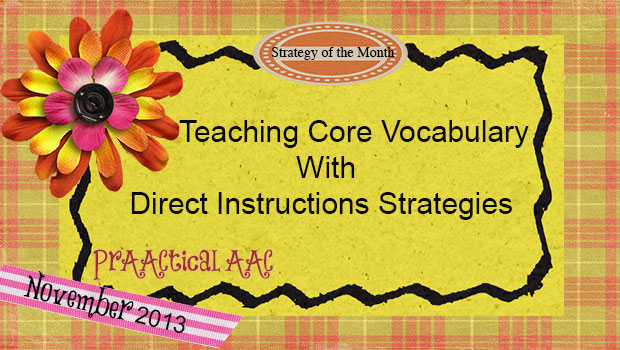
Vocabulary instruction involves a systematic TEACHING process. Core vocabulary words are harder to represent with pictures but still need to be taught with direct instruction. Many of the strategies and activities are part of general vocabulary teaching. Decide your core word vocabulary to teach and begin with strategies, steps, and fun activities. Teaching Strategies Teach in Meaningful Language Experiences– Create activities about the words but also about the communication behind the words. Develop activities that are meaningful to the learners. Provide Active Participation Opportunities- Develop many, many (many) opportunities for the learners to use the vocabulary as an expressive communication tool as well as for receptive language. Have the learner interact with the core word vocabulary rather than just listen to explanations. Give the vocabulary communicative power for the learner. Use Aided Language Input– Model AAC style. Use Focused Language Stimulation – Highlight new words and use them repetitively. We like... [Read More...]
November 8, 2013
by Robin Parker -
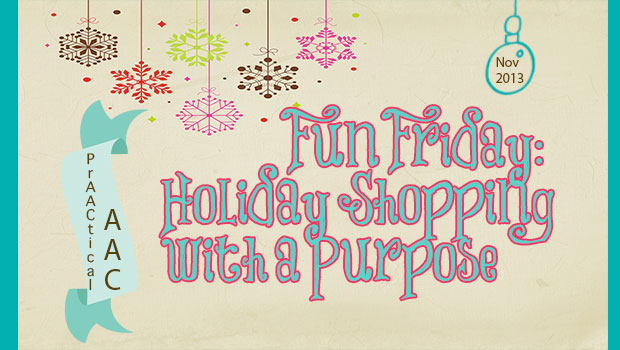
The holidays are prAACtically here and depending upon the holiday traditions you celebrate they may be closer than you realize. Chanukah begins the day before thanksgiving and we never think it is too early to shop for Christmas or any other holiday, so here are some great companies to help you get started. We will update this holiday shopping list a few times throughout this holiday season. Please send any additional companies you feel should be included. Paper Clouds Apparel– Get t-shirts, hats, and totes featuring artwork designed by individuals with special needs. Paper Clouds apparel also hires individuals with special needs to package all of the products. and more. Paper Clouds Apparel was formed to showcase the creative minds and artistic abilities of individuals with special needs while raising funds to provide financial support for special needs schools and organizations. Fifty percent of the net proceeds from the sale of... [Read More...]
October 31, 2013
by Robin Parker -
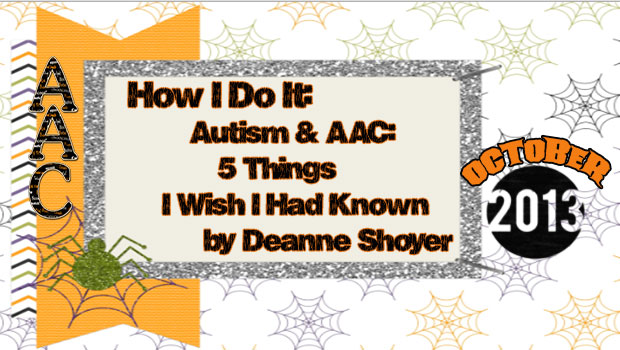
We are so pleased to have connected with Deanne Shoyer from Small But Kinda Mighty and even happier that she is our guest blogger today. Deanne is a mom of twin boys who both are on the autism spectrum. Deanne successfully fundraised to buy iPads for her boys and has been active for more than 3 years in social media and in the special needs app community. She has written about many things but often focuses on implementing AAC in a very PrAACtical way. Please feel free to share this very important post as she highlights AAC, what she has learned, and how it may help others. by Deanne Shoyer at Small But Kinda Mighty (original post at Small But Kinda Mighty) In the title of this post I’ve linked autism and AAC for a specific reason. A lot of the points here are equally applicable to people who have a... [Read More...]
October 26, 2013
by Robin Parker -
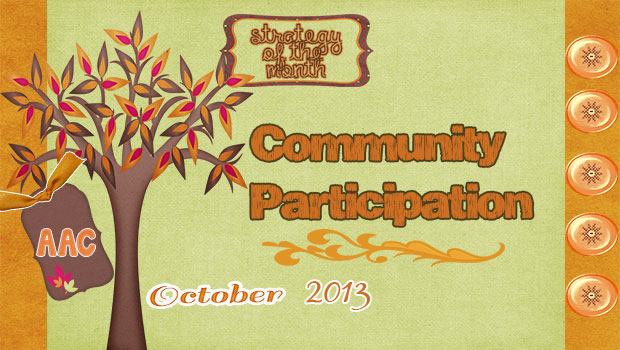
Community participation and communication for AAC users is an integral part of of developing, growing up, and having inclusive opportunities. We often relate community participation to quality of life indicators. Community participation for AAC users begins from the… beginning. Young children can order in restaurants, use picture menus, and have access to many inclusive events. As children grow into adolescents and adults, community participation involves post secondary options, employment, and community living. Perspectives from AAC Users Have communication displays and devices available at ALL times– You need access to a communication system(s) to participate in all situations. Remember to take AAC with you. The sooner the AAC user becomes responsible for taking or telling someone to take the device/displays with them the easier it becomes. For mobile technology systems, there are rugged cases that withstand wind, water, even medical waste (see Lauren Enders Pinterest boards for case and accessory options).... [Read More...]
October 24, 2013
by Robin Parker -

Cooking is a great activity as the platform for meaningful language experiences for both children and adults. Halloween often involves candy and tasty treats. However, there are also plenty of healthy Halloween foods (e.g., carrot pumpkins, tangerine & celery pumpkins, or apple teeth to name just a few). Then comes Thanksgiving and all the recipes that go along with it (e.g., lots of opportunity for repetition with variety). Everyone can be involved with cooking, although just because you cook doesn’t mean you need a stove. From spooky chex mix to more elaborate cookie and cake decorations, there is a ton of active participation and conversation that can be incorporated into cooking. And the fun and rewards (eating) are built-in. Although there are plenty of Halloween recipes, many recipes can be turned ‘spooky’ with an addition/modification of Halloween shapes or colors. You can cook using core words and/or focusing on the... [Read More...]









